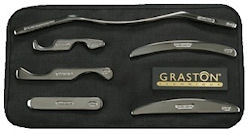- Community
-
Programs
- Schools
-
Careers
- RN Specialties
- Best RN Jobs and Salaries
- Aesthetic Nurse
- Nursing Informatics
- Nurse Case Manager
- NICU Nurse
- Forensic Nurse
- Labor and Delivery Nurse
- Psychiatric Nurse
- Pediatric Nurse
- Travel Nurse
- Telemetry Nurse
- Dermatology Nurse
- Nurse Practitioner
- Best NP Jobs and Salaries
- Family NP (FNP)
- Pediatric NP
- Neonatal NP
- Oncology NP
- Acute Care NP
- Aesthetic NP
- Women's Health NP
- Adult-Gerontology NP
- Orthopedic NP
- Emergency NP
- Psychiatric-Mental Health NP (PMHNP)
- APRN
- Nurse Educator
- Nurse Administrator
- Certified Nurse Midwife (CNM)
- Clinical Nurse Specialist (CNS)
- Certified Registered Nurse Anesthetist (CRNA)
- Resources
- Education

 graston technique: developed in usa in 80`s, as a x- friction protocol using a set of six stainless steel tools over myotendinous tissues. research (davidson et al 1997, gehlsen 1999) shows the benefits appear to stem from disruption of scar tissue within the tendons and connective tissues, and the subsequent inflammatory response (as in prolotherapy, cyriax)
graston technique: developed in usa in 80`s, as a x- friction protocol using a set of six stainless steel tools over myotendinous tissues. research (davidson et al 1997, gehlsen 1999) shows the benefits appear to stem from disruption of scar tissue within the tendons and connective tissues, and the subsequent inflammatory response (as in prolotherapy, cyriax)
Hortonjj
3 Posts
Im currently researching soft tissue therapy and I came across the Graston Technique that started in '94. I am curious to know is this technique inspired by a tool the Romans, as well as other cultures used called a Strigil? I understand that this tool was mostly used for cleaning off dirt and oils, but did it not essentially provide the same results that the Graston technique provides? Thank you in advance for your input!